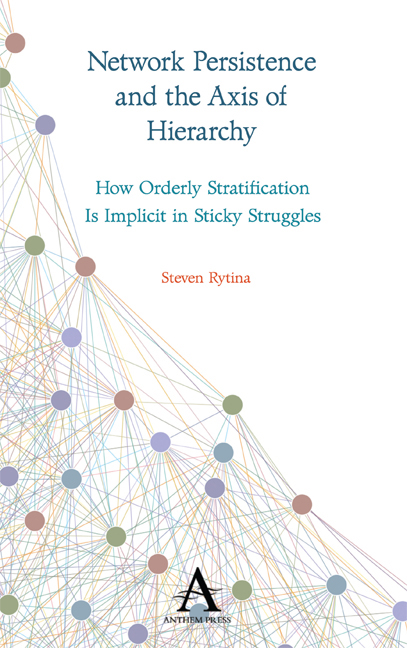 Network Persistence and the Axis of Hierarchy
Network Persistence and the Axis of Hierarchy Book contents
- Frontmatter
- Contents
- List of Illustrations
- Preface
- Chapter One Sticky Struggles: The Unified Pattern of Social Ranks Inherent in Networks
- Chapter Two Foundations of Cacophony
- Chapter Three Knots of Regularity
- Chapter Four Hierarchy: Inevitable but Inevitably Messy
- Chapter Five The Inevitable Emergence of Stratification
- Chapter Six Scaling Intergenerational Continuity: Is Occupational Inheritance Ascriptive After All?
- Chapter Seven Taming the Mobility Table
- Chapter Eight Is Occupational Mobility Declining in the United States?
- Chapter Nine The Continuum of Class over Time: Deconstructing Imposed Class to Uncover Empirical Classes
- Chapter Ten Concluding Reflections
- Appendix Why Robust Attraction Is (Effectively) Inevitable for Mobility Data
- Index
Chapter Nine - The Continuum of Class over Time: Deconstructing Imposed Class to Uncover Empirical Classes
Published online by Cambridge University Press: 30 April 2020
- Frontmatter
- Contents
- List of Illustrations
- Preface
- Chapter One Sticky Struggles: The Unified Pattern of Social Ranks Inherent in Networks
- Chapter Two Foundations of Cacophony
- Chapter Three Knots of Regularity
- Chapter Four Hierarchy: Inevitable but Inevitably Messy
- Chapter Five The Inevitable Emergence of Stratification
- Chapter Six Scaling Intergenerational Continuity: Is Occupational Inheritance Ascriptive After All?
- Chapter Seven Taming the Mobility Table
- Chapter Eight Is Occupational Mobility Declining in the United States?
- Chapter Nine The Continuum of Class over Time: Deconstructing Imposed Class to Uncover Empirical Classes
- Chapter Ten Concluding Reflections
- Appendix Why Robust Attraction Is (Effectively) Inevitable for Mobility Data
- Index
Summary
The hypothesis of a principal dimension of stratification is in obvious tension with social class concepts. “Class” has been used in many ways, but I will focus on recent usage in which class has come to connote a limited number of discrete categories. The principal dimension is a continuum. A long tradition holds that continuum and class are conceptual choices, not open to empirical adjudication.
I will present argument and evidence that is contrary and then, contrary again. I will show, first, that the principal dimension does render coded class moot, at least for problems of mobility. However, I will also show how clearing away convention reveals an unexpected bonus. The novelty is a distribution of hills separated by valleys. This divided terrain maps really existing classes that describe divided labor in the UK and the USA. In sum, I will propose that class is liable to empirical challenge. However, while coded classes fail that challenge, using oft- analyzed mobility data, in their stead appear empirical classes that correspond to actual mobility patterns.
The chapter will feature the most prominent class schema in use, the Nuffield tradition (named for the Oxford college where much of the development took place). The first version to gain wide prominence appeared in Goldthorpe, Llewellyn, and Payne’s (1980) report of the Oxford Mobility Study. A slight variant, moving one of the 36 coarse aggregates that are the least elements distinguished (discussed below), was first used by Erikson, Goldthorpe, and Portocarero (1979). This will be referred to as the EGP schema. This variant is the centerpiece of the work presented in Erikson and Goldthorpe (1992) and will be featured in the analyses that follow.
Plainly, addressing this class schema empirically denies any supposed privileged, preempirical status for conceptual options such as category versus continuum. The grounds are simple. The enlarged framework for estimation of Chapter 7 will be deployed. This framework leads to estimates that are exact numerical replicates of the tabular models reported by Goldthorpe, Llewellyn, and Payne (1980) and Erikson and Goldthorpe (1992). The estimation framework also contains the principal dimension.
Thus, coded class can be pitted against the continuum of the principal dimension. Due to robust attraction, the principal dimension almost entirely subsumes class. The analysis draws on the Nuffield class schema and Goldthorpe, Llewellyn, and Payne’s (1980) Oxford Mobility Study data. The dramatic result is a correlation exceeding .98.
- Type
- Chapter
- Information
- Network Persistence and the Axis of HierarchyHow Orderly Stratification Is Implicit in Sticky Struggles, pp. 279 - 306Publisher: Anthem PressPrint publication year: 2020


